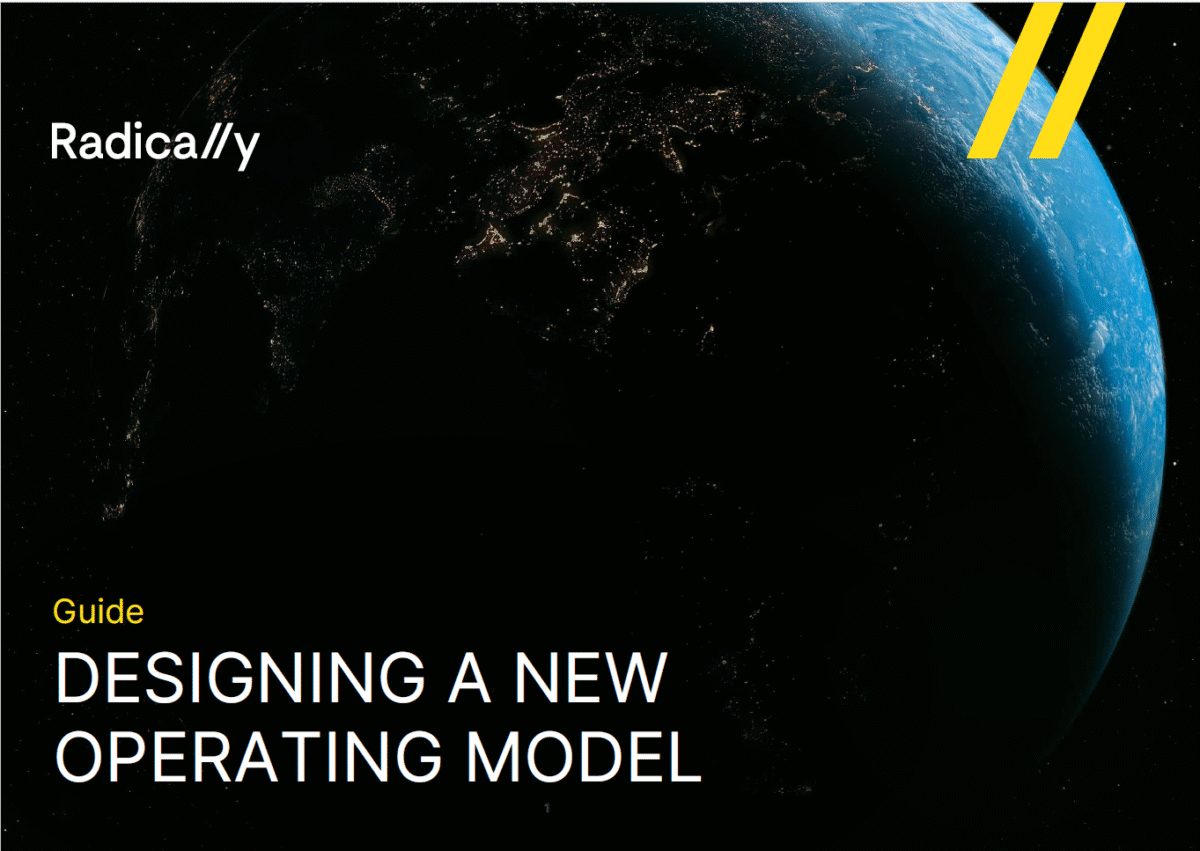We've seen this pattern before. Ten years ago, everyone wanted Agile, so they installed Agile frameworks. To then scale it, they installed SAFe. To alter their operating model, they installed the Spotify model – a model designed for a streaming music service. And now they’re doing the same with the Product Operating Model.
Here's the problem: most organisations implementing a product operating model haven't stopped to ask whether it's the right model for them.
They saw it work at a tech company. Their competitor mentioned it at an industry event. A consultant shared a case study. So they started the restructuring, hired product managers, reorganised around product lines, and expected that copying the structure would deliver the results they saw elsewhere.
This is the trap. And we've seen it cost organisations millions in failed transformations, disrupted teams, and abandoned initiatives.

The Product Operating Model Cookie-Cutter Trap: Structure Without Strategy
The mistake is treating operating models as one-size-fits-all solutions. They aren't.
An operating model is how an organisation structures itself to execute on what it's trying to achieve. The critical word there is "what it's trying to achieve."
The operating model must follow strategy, not the other way around.
We worked with an insurance company recently that made exactly this mistake. Over decades, they'd built something remarkable: a deep, trust-based relationship with their customers. Some staff knew customers personally. Claims adjusters had the authority to make exceptions because they understood the context. Their competitive advantage wasn't product or innovation—it was intimate customer knowledge and the ability to customise solutions.
So what did they do? They implemented a Product Operating Model because that's where the industry was moving. They reorganised around insurance products and created product teams. The structure looked right. It was what everyone else was doing.
But within months, they realised the structure was working against their strategy. Product teams were optimising for product metrics. Customers were bouncing between product silos. The very thing that had made them successful—understanding the whole customer—was being erased by a model designed for a different kind of competitive advantage.
When we asked them, "What has made you successful?" the answer wasn't "innovation in products." It was "understanding our customers deeply and having the flexibility to serve them." A customer-centric operating model would have been far more powerful than a product-centric one.
Three Value Disciplines: Your Strategic Foundation
Before you choose an operating model, you need to understand what you're trying to win at.
Treacy and Wiersema identified three fundamental value disciplines that organisations compete on, and in working with organisations across industries, we've seen that understanding these disciplines is absolutely critical to choosing the right structure.

Operational Excellence: you win by being the low-cost provider. Your operating model emphasises efficiency, process optimisation, and continuous cost reduction. Think Pak N Save, or McDonald's —companies that have structured themselves entirely around ruthless efficiency. Every process is standardised. Every cost is examined. Their entire organisation is built to execute flawlessly at scale.
Product Leadership: You win by being first to market with the most innovative solutions. Your operating model emphasises speed, creativity, and rapid commercialisation. Apple and Tesla didn't ask for permission to break conventions; they asked for funding to experiment. Their structures prioritise R&D, rapid iteration, and freedom to fail fast.
Customer Intimacy: You win by delivering deeply customised solutions tailored to individual customers. Your operating model emphasises relationships, empowered frontline decision-making, and flexibility. At Radically, we have built our entire business around understanding what individual customers need. Our team have the authority to make decisions because they understand the customer context better than anyone else.
Here's the insight we've repeatedly observed across industries: you cannot excel at all three.
The resources, processes, incentives, and cultures that make you brilliant at one actively work against excellence in the others. You have to choose. And once you've chosen, your operating model must be designed specifically to support it.
Choosing Your Value Discipline
We work with organisations that realise the importance of designing an operating model that fits their business's unique attributes.
Sometimes, we work with companies that have realised their existing template-based operating model isn't working. They've copied a structure, trained teams, and implemented processes—and nothing clicks because the structure doesn't align with what actually drives their competitive advantage.
The fix isn't to copy a different template. It's to do the more complex work of understanding the organisation deeply—the history, market, people, capabilities—and then designing an operating model that flows from that understanding.
We recently worked with a large Australian energy company on exactly this challenge. They needed to modernise—to accelerate delivery and respond faster than competitors in an intensely competitive market. But the real work wasn't picking a framework. It was understanding their business design: where they play, what makes them unique, and how they actually win.
The result? A custom operating model built around value streams, explicitly designed for their context and strategy. Not a template. Not something copied from a tech company. Something that worked for them.
The outcome speaks for itself: $6M in cost savings, dramatically accelerated delivery, reduced silos, and—crucially—people who actually understood why the structure existed and how their work mattered.
That's what happens when operating model design starts with strategy rather than structure.

The Strategic Choice Framework: Three Questions Before You Restructure
So before you reorganise, ask yourself three essential questions:
- Where do you play? What markets, customer segments, and channels define your business? What are you truly excellent at serving? The insurance company had spent many decades deeply understanding that specific segment.
- How will you win? Which value discipline is your competitive advantage? Are you winning on cost? On innovation? On deep customer relationships? The insurance company's answer was crystal clear: customer intimacy. That was their moat, their defensible advantage.
- What is your operating model? Only once you've answered the first two questions do you design your structure. If you're winning on customer intimacy, you need a model that gives frontline teams customer context and real decision-making authority. If you're winning on product innovation, you need rapid experimentation and creative autonomy. If you're winning on operational excellence, you need process discipline and cost accountability.
The operating model follows from the strategy. Not the other way around.
What Gets Built When You Get It Right
We've seen organisations transform when they finally align structure with strategy. Mercury and TrustPower merged two organisations with distinct cultures. Instead of imposing a template, we worked with their leadership to understand what unified success would look like—then designed an operating model to enable it. The judges called it "a masterclass in laying the right foundations for success." It won NZ Business Transformation of the Year.
Bankwest transformed to a fully digital bank. Vodafone overhauled its delivery model. Auckland Transport reshaped to become adaptive in a changing transport landscape. In every case, the common thread wasn't the type of operating model. It was the care taken to ensure the structure matched the strategy—and the commitment to involve people throughout, not just impose change.
Why Operating Model Strategy Alignment Matters
Getting this wrong is expensive. We've seen organisations that restructure without strategic clarity spend millions on change management, retrain teams multiple times as the structure keeps shifting, and watch engagement and productivity crater as people navigate confusion and misalignment.
Worse, they've externalised the cost. Teams that once made fast decisions now wait for three layers of approval. Customers who got personalised service now get routed through product silos. Frontline employees who had authority now have a process instead.
But getting it right is transformative. When your operating model actually reinforces your competitive advantage—when your structure, incentives, and decision-making patterns all align with how you're trying to win—something shifts. Strategy actually reaches teams. Execution becomes efficient. And your organisation moves with clarity and speed, not confusion and drift.
The product operating model isn't bad. It's just not the answer for everyone. Consider the strategic landscape before blindly copying what everyone else is doing.

The Real Work: Where Radically Comes In
Before you hire consultants to restructure, before you invest millions in reorganisation, before you adopt the model that worked elsewhere, ask: What has made us successful? What are we uniquely good at? Which value discipline is our edge?
Answer those questions first. Then choose your operating model.
Everything else will be faster, cheaper, and actually work.
Because the organisations that win aren't the ones that copied the best structure. They're the ones who designed a structure that reflects who they are and how they actually compete.
Interested to learn more? Download our free Operating Model Guide.
